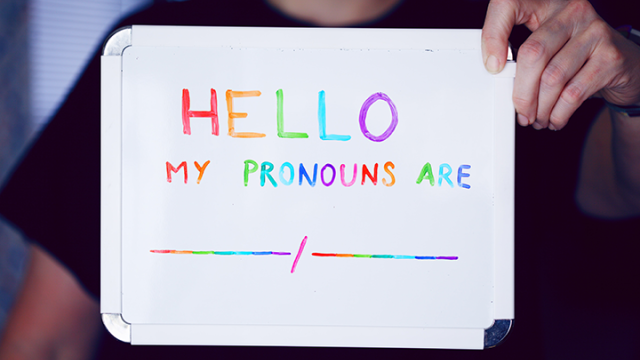Putting diversity and inclusion at the heart of your event

While we live, work and play in a society that likes to use labels and pigeonhole people, at FCM Meetings & Events we believe in the power that comes from having the freedom to be yourself. Afterall, everyone loves seeing themselves represented in the media, business and community, right? That’s why we also believe that every event, or meeting, needs to take an individual approach to embracing diversity and inclusion to authentically celebrate the identity of individuals within the collective whole.
In short, people identify with others who are like them. In an event setting, this transforms interactions between individuals and teams, and encourages information exchange. Creating authentic and accessible experiences for everyone elevates events and meetings, exposing the audience to different and powerful new perspectives and viewpoints.
This focus on diversity and inclusion was a hot topic at the recent Ideas Exchange event hosted by FCM Meetings & Events and it is one that is here to stay.

“I’ve noticed a significant shift over recent years, as our clients are more aware of addressing diversity and inclusion when planning events,” said David Twyman, FCM Meetings & Events, Creative Director – Production. “And importantly, they can see the strength that comes from designing an event that champions a breadth of different experiences.”
When we talk about diversity and inclusion, it’s about shining a light on all of its many forms including – gender, religion, age, culture, status, education, people of colour and those living with disability or disadvantage. So how can the meetings and events industry create inclusive experiences that elevate the voices of all? Here are some of our tips.
Personalise your plan
“At the planning stage we work with clients to help them create an event that drives business change and social change,” said David. “We break their brief apart to understand who their people, or audience, is. We ask what their values are and what does the business want to stand for? From there we can build a picture of their vision for the event.”

Before you start anything do your research to understand the audience, their values, objectives, backgrounds and potential sensitivities – and to understand what diversity and inclusion mean to them. “Everyone benefits when this is factored into the planning,” said David. “The result is an event that showcases different perspectives, resources, engagement, new ideas, experiences, language and understanding.”
Plan to be inclusive from the very start. For example when building an event registration page on the internet, make sure the content is accessible to all. Inclusivity and access means catering for people with disabilities, so everyone gets the best experience. That means if you have an event video, the audio needs to be captioned or signed for the hearing impaired. The website needs to also cater to blind and visually impaired people too.

Curate your content
“We can all appreciate how important it is for everyone to see themselves reflected in society – and also in the hierarchy and culture of a business,” said David. “Taking steps to embed diversity into your content doesn’t take anything away from others, instead it enhances their experience by building empathy, connection and understanding.”
When creating and designing the content for your event or meeting, you have many different opportunities to showcase and embrace diversity and inclusion. From the speakers you engage, to the catering, entertainment, the suppliers you choose and the venue itself. Carefully considered choices can all enrich your event and provide exposure to different points of view.
Engage with the audience before the event, where possible, to help them shape the content and to have a say in what they consider important. By employing a democratic and decentralised event concept, you are putting the power in the hands of the audience – creating an inclusive experience which they can participate in fully. At FCM Meetings & Events latest Ideas Exchange, pre-event questions and answers from attendees were worked into the format to help inform the topics covered and to guide the panel discussion.
Tips
Know your audience
We have mentioned this multiple times already, but it really is the key to creating an inclusive experience. Having just celebrated Pride month, a great example is enabling attendees, or speakers, to set their pronouns on registration forms, online profiles and name tags. Be sure to include the most common pronouns — he/him/his, she/her/hers, and they/them/theirs, while also allowing for custom pronouns.

Avoid tokenism
Don’t make a superficial gesture just to tick the ‘diversity box’. Weave your commitment throughout the event in a genuine way, to inform and engage with your audience. Instead of rattling off a standard acknowledgement of country at your event, try to personalise the message to your event or venue location. Also don’t jump on the bandwagon because it’s trendy or gives your brand kudos. For example, if you’re planning a corporate Gay and Lesbian Mardi Gras event or float …are you able to embed your LGBTQI commitment and culture into a day-to-day basis and in all your corporate events throughout the year rather than just a one-off event?

Don’t worry that you’ll get it wrong
No one wants to make a blunder, but in most cases if you’re making a genuine gesture it will be appreciated. If you have any doubts, you can test the water with a few potential attendees first to get their feedback. “It’s about starting the discussion and being open to other people’s stories and experiences,” said David. “My personal passion is championing recognition of our indigenous and first nations people. But I know some businesses are afraid they will get it wrong. But you really can’t go wrong if you acknowledge people respectfully and you are grateful for the contribution they have made to this country.”


